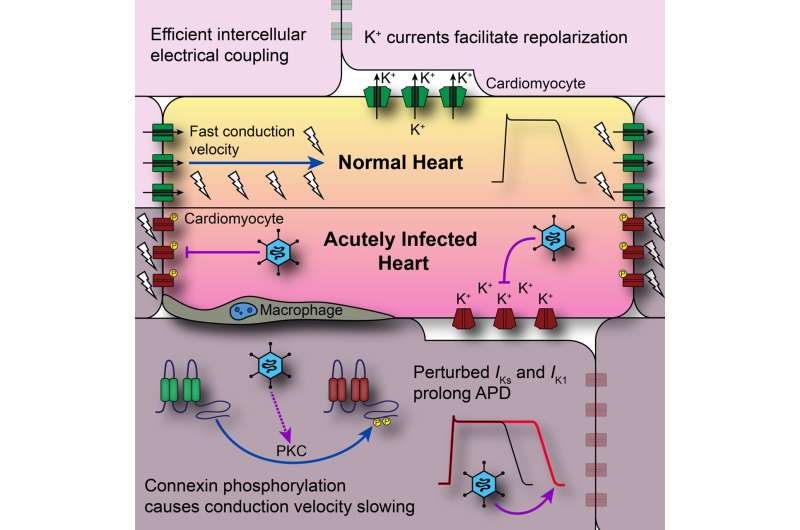This article has been reviewed according to Science X's editorial process and policies. Editors have highlighted the following attributes while ensuring the content's credibility:
fact-checked
peer-reviewed publication
trusted source
proofread
Revealing a hidden threat: Researchers show viral infections pose early heart risks

In a potentially game-changing development, scientists with the Fralin Biomedical Research Institute at VTC have revealed a new understanding of sometimes fatal viral infections that affect the heart.
Traditionally, the focus has been on heart inflammation known as myocarditis, which is often triggered by the body's immune response to a viral infection.
However, a new study led by James Smyth, associate professor at the Fralin Biomedical Research Institute, sheds new light on this notion, revealing that the virus itself creates potentially dangerous conditions in the heart before inflammation sets in.
The discovery, appearing in Circulation Research, suggests completely new directions to diagnose and treat viral infections affecting the heart.
Given the high incidence of viral-related myocarditis leading to sudden cardiac death, the insight is crucial. Up to 42% of sudden cardiac deaths in young adults are attributed to myocarditis, and of these cases viral infection is the leading cause.
"From a clinical perspective, our understanding of viral infection of the heart has focused on inflammation, causing problems with the rate or rhythm of the heartbeat," Smyth said. "But we have found an acute stage when the virus first infects the heart and before the body's immune response causes inflammation. So even before the tissue is inflamed, the heart is being set up for arrhythmia."
To make this discovery, researchers focused on adenovirus, a common culprit in cardiac infection and myocarditis, using mouse adenovirus type-3 to replicate the human infection process.
They found that early in the infection, the virus disrupts critical components of the heart's communication and electrical systems.
As a result, even before symptoms appear, the adenoviral infection creates conditions that disrupt the heart's gap junctions and ion channels, according to virologist Rachel Padget, the study's first author who worked in the Smyth lab while completing a doctoral degree from the Virginia Tech Translational Biology, Medicine, and Health graduate program.
Gap junctions are like tiny tunnels between heart cells that allow them to communicate, and ion channels are like gates in the cell membranes that help maintain the right balance of ions needed for the heart to generate normal patterns of electrical activity that allow it to beat properly.
When adenoviral infection disturbs these communication bridges and gatekeepers, it creates a situation where the heart might develop irregular patterns of electrical activity called arrhythmias affecting its mechanical beating and blood pumping capacity, and that can lead to sudden cardiac problems, especially in people with active infections.
Now, by targeting specific heart changes induced by viral infections at the molecular level, researchers aim to reduce the risk of cardiac issues in people grappling with viral illnesses.
"Individuals who have acute infections can look normal by MRI and echocardiography, but when we delved into the molecular level, we saw that something very dangerous could occur," Smyth said.
"In terms of diagnostics, we can now work with our colleagues here to start looking for ways to analyze blood for a biomarker of the more serious problem. People get cardiac infections all the time and they recover. But can we identify what's different about individuals that are at a higher risk to have the arrhythmia, possibly through a simple blood test in the doctor's office."
More information: Rachel L. Padget et al, Acute Adenoviral Infection Elicits an Arrhythmogenic Substrate Prior to Myocarditis, Circulation Research (2024). DOI: 10.1161/CIRCRESAHA.122.322437



















